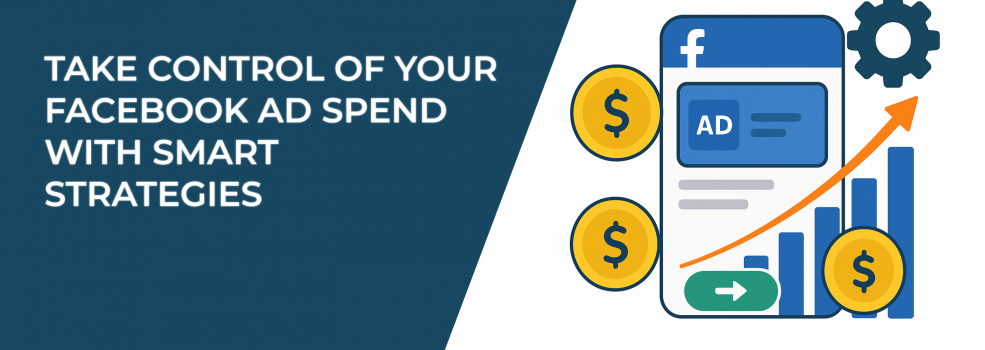Facebook ad costs continue to rise, competition intensifies, and targeting tools are evolving quickly. For many small business owners and marketers, budgets haven’t grown at the same pace — and that means every dollar needs to work harder.
The good news? You don’t need a massive budget to drive meaningful results. What you need is control over your targeting, messaging, optimization, and spend. That control isn’t automatic; it comes from being intentional, strategic, and consistently informed.
Let’s explore how advertisers today are taking smarter steps to reduce wasted spend, boost performance, and gain more value from every campaign.
Understand exactly who you’re targeting and why
Before launching any campaign, it’s essential to define your audience with clarity and purpose. Basic demographic data — age, gender, location — is no longer sufficient. To achieve real efficiency, you need to understand your audience’s mindset, habits, motivations, and pain points.
Recent changes to Facebook’s targeting options have made this more challenging. With the removal of many interest categories and an increased push toward machine learning, advertisers can no longer rely on broad targeting suggestions alone.
Instead, focus on building high-quality, first-party data:
-
Use lead magnets, gated content, and email opt-ins to collect user information.
-
Create Custom Audiences from your customer list, website traffic, app users, or social media engagement.
-
Develop Lookalike Audiences from your most valuable users — such as those with high lifetime value or frequent purchases — not just from general leads.
From there, tailor messaging to each segment. Someone who just discovered your brand will respond differently than someone who abandoned their cart yesterday.
Accurate targeting isn’t just about reaching more people — it’s about reaching the right people at the right time with the right message.
If you need a foundational refresher or want to refine your approach, start with this guide on Facebook Ad Targeting 101 — it breaks down the core principles of reaching the right people on Meta’s platforms.
Don’t rely on the algorithm alone
Facebook’s ad delivery system is impressive — but it isn’t infallible. The algorithm is designed to optimize for what it believes will get the most immediate results. That can sometimes lead to a focus on quantity over quality, such as generating low-intent leads or click-throughs that never convert.
While automation can improve efficiency, advertisers need to stay actively involved in campaign oversight. That means regularly analyzing performance data — not just top-line metrics like CPM and CTR, but more meaningful indicators of ROI.
Key metrics to track include:
-
Cost per qualified lead or purchase,
-
Post-click engagement (e.g., time on site, bounce rate),
-
Conversion rate per creative and audience,
-
Frequency and ad fatigue signals.
Take a proactive approach. If an ad is driving a high number of clicks but little conversion, investigate whether the messaging is aligned with your landing page. If an audience segment consistently underperforms, shift budget elsewhere or refine the creative.
Successful advertising depends on informed decisions. The algorithm can assist, but you must direct the strategy.
Segment your budget strategically
One of the most effective ways to regain control over ad spend is by dividing your budget based on the user journey. Rather than concentrating your investment in a single campaign, consider allocating resources across multiple funnel stages.
Here’s a hypothetical framework to consider:
-
Top-of-Funnel (Awareness) — 40%: target broader audiences with educational or brand-building content. Focus on storytelling, product value, or industry insights that introduce new users to your brand.
-
Middle-of-Funnel (Consideration) — 30%: retarget users who’ve engaged with your brand but haven’t yet converted. Showcase benefits, testimonials, or product demonstrations to build trust and address objections.
-
Bottom-of-Funnel (Conversion) — 30%: focus on users who are already close to purchase. Use dynamic product ads, limited-time offers, and cart abandonment strategies to encourage action.
Allocate a portion of your monthly budget — around 10–15% — for testing new creatives, formats, or audiences. This will allow you to experiment without disrupting your core campaigns and help identify future high-performing assets.
Treat your ad budget like a portfolio — diversified, performance-driven, and regularly adjusted based on results.
Invest in high-quality creative and keep testing
Creative assets remain one of the most important variables in campaign success. No matter how refined your targeting is, uninspired or unclear creative can undermine your results.
In today’s environment, ad creative needs to stand out immediately — especially on mobile. Think bold visuals, strong headlines, and messaging that speaks directly to your audience’s needs or emotions. Short-form video, user-generated content (UGC), and dynamic carousels all remain effective formats in 2025.
To improve creative performance:
-
Start with a clear hook. The first 1–2 seconds are critical to capturing attention.
-
Keep branding subtle but visible — viewers should know it’s your brand without being overwhelmed by logos.
-
Use subtitles for video content. Many users browse with sound off.
-
Create multiple variations of each concept. Change up the headline, visuals, or call-to-action to see what resonates best.
Establish a rhythm of creative refreshes — ideally every 2 to 4 weeks — to combat ad fatigue and maintain engagement. Keep a creative testing schedule that runs parallel to your main campaigns so that new ideas are constantly being evaluated and optimized.
Effective creative isn’t just visually appealing — it’s strategically designed to move your audience through the funnel.
Use automation with oversight
Facebook and Instagram now offer a range of automation tools, including Advantage+ campaigns, Dynamic Creative, and rule-based budget optimization. These tools are powerful — but they perform best when paired with human oversight and strategic input.
When using automation:
-
Start with strong inputs: only use high-performing creatives and well-defined audience segments. Automation is only as effective as the materials you feed into it.
-
Set clear boundaries: establish ROAS minimums, budget caps, or CPA limits to avoid runaway spend.
-
Monitor early performance: pay close attention during the learning phase of any automated campaign. Adjust quickly if performance trends in the wrong direction.
-
Apply automation to specific use cases: for example, Advantage+ Shopping Campaigns work well for e-commerce brands with large product catalogs — but may be less effective for service-based businesses.
Think of automation as a tool to enhance scale — not to replace your role in strategy or analysis. With proper oversight, these systems can free up time while maintaining control over key outcomes.
Eliminate underperforming elements
Every dollar counts — and that means anything underperforming should be identified and removed quickly.
It’s easy to hold onto an ad that once worked or to give a new campaign “a bit more time,” but this mindset can lead to wasted spend. Regularly auditing your campaigns helps keep your strategy agile and your budget lean.
Schedule weekly or bi-weekly performance reviews, and look for signs like:
-
Declining CTR or conversions,
-
High CPM with little engagement,
-
Increased frequency without improved performance,
-
Audience overlap that creates bidding competition among your own campaigns.
Come up with rules for pausing or replacing low-performing elements. For example:
-
Pause any ad set with CPA exceeding your target for five days straight.
-
Rotate creative if frequency exceeds 2.5 without consistent engagement.
-
Remove placements (such as Audience Network) that consistently deliver poor quality traffic.
The goal is to create a system of continual optimization — where strong performers receive more investment and weak elements are promptly removed or reworked.
For a more advanced approach to campaign evaluation, take a look at this breakdown of deeper ad metrics — it’s designed for marketers who want to understand what’s actually driving performance. And if you've ever seen the warning “Ad Set May Get Zero” and wondered what caused it, this troubleshooting guide can help you resolve it before it affects your budget.
Final thoughts
Effective Facebook and Instagram advertising requires more than just creativity or budget. It demands discipline, insight, and a commitment to continuous improvement.
By understanding your audience deeply, segmenting your strategy thoughtfully, using automation with care, and refining performance regularly, you don’t just cut waste — you create room for growth.
This level of control gives you something else, too: confidence. Confidence in your decisions, in your messaging, and in the results you’re working toward.
So ask yourself: are you making your ad budget work for you, or is it working against you?

